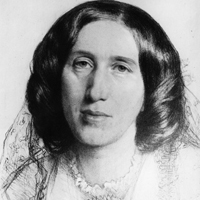The Rustic Scenes in Eliot's Adam Bede
The very opening of the novel Adam Bede offers a set of rustic scenes. The opening scene is the carpenter's workshop where Adam works in the sunlight, his plane sending out pine-wood shaving to mingle their scent with the elder bushes outside the open windows. In this opening scene Adam is seen singing.

Mary Ann Evans (George Eliot)
The whole scene (the carpenter's work, the sunshine, the song of religious celebration) has the serenity characteristic of Adam and his community, the serenity of people untroubled their larger views. The sunshine itself seems to guarantee the human light of intention and reverence. The beauty of Hayslope is described. The beauty of Hayslope is represented as a reflex of the human richness in its midst. The moment of the birthday feast exclusively deals with a ritual celebration that is a long timeless moment in the novel. This celebration ritual marks the supreme pastorality and rusticity. The dinner, the health—drinking, the games and the dance all have their time honored protocols. All these acts performed at the moment of birthday celebration mark the renewal of a traditional, even feudal social organization.
The setting of the novel is itself a major rustic element. The setting of Adam Bede is a community of Hayslope. It is a fertile and sheltered land; a region of corn and grass. The luxury of life and prosperity is a common feature of such land. Poverty is rare. It is regarded by the Poysers who don't want to go away, leaving their roots behind. Hayslope is a fictional rural community rooted in custom which change threatens and alters. Book I introduces the separate households and separate ways of the main characters. Adam Bede is a character like his father and lives with his brother Seth in the cottage. He lives under the care of his querulous mother. The Poyser household at Hall farm, compared with the plain, is full of vitality, with its diary, orchards, meadows and children. Mrs. Poyser is the voice of rustic tradition and community. Her home, The Hall farm, provides a background that illustrates her character vividly. The Hall farm is the center of comfort, love, energy, security, peace which all characters recognize except Hetty. To some extent, the occupation and professions of the characters are also associated with rustic life like they are mostly farmer, carpenter, common laborers, the village schoolmaster, clergy, dairy maid, wage earners etc.
Rustic life gets reflected in the surrounding life of squire Donnithorne. Arthur Donnithorne lives with his grandfather at the Hall, a hereditary establishment for a hereditary landlord. The small but rented household of the Reverend Irwine completes the group. The Reverend Irwine is one of George Eliot's sympathetic portraits of the honorable effective clergyman. He is comfortable in his elegant habits. But he is mindful of duties to a widowed mother and sickly sister. He is far better for his parishioners than a more dogmatic and consistent man could ever be.
These various households are all linked by a common social order. All these households rest in the sense that their communal ways are right. They all belong to the same community. They go to the same church on Sunday. They observe the same rituals of celebration and sorrow. Hayslope community is a concentric universe whose rhythmic harmonies has retained undisturbed for centuries. The problem in Hayslope is not an absence of community, but absence of self-consciousness and responsibility about community and consequently, a fatal lack of control over it.
Particularly speaking, there are lots of concrete rustic scenes. The place where Seth Bede proposed to Dinah Morris is a rustic place. A secret place in between the Hall and the farm, where Hetty and Arthur Donnithorne consummated their love, is also a rustic element. The dueling place, where Adam Knocked Arthur unconscious, is also a rustic element. In a certain lonely place beside a jungle where Hetty Sorrel gave birth to her illegitimate infant is also a pastoral element.
In this way, Eliot's descriptions of the country people have all the warmth and color of reality, but it is the reality in the service of imagination. However, Eliot is very much concerned with the rustic scenes either she connects this rustic scene with some land or with the characters or with these character's professions and occupations or customs and tradition. So, as a whole if we survey the Adam Bede we can find ourselves deeply drown in these rustic scenes explored by the novelist, Eliot.
Literary Spotlight
Introduction of Eliot's Adam Bede
Determinism in Eliot's Adam Bede
Social Realism in George Eliot's Adam Bede
Moral Concerns in Eliot's Adam Bede
Narrative Technique in Eliot's Adam Bede
Study of Female Protagonist in Adam Bede
Comparative Study of Hetty and Hester
Image and Symbols in Eliot's Adam Bede
Multiple Themes in Eliot's Adam Bede
 |
bachelorandmaster.com |